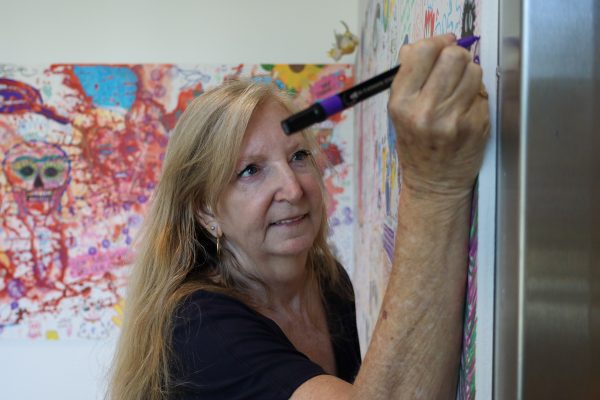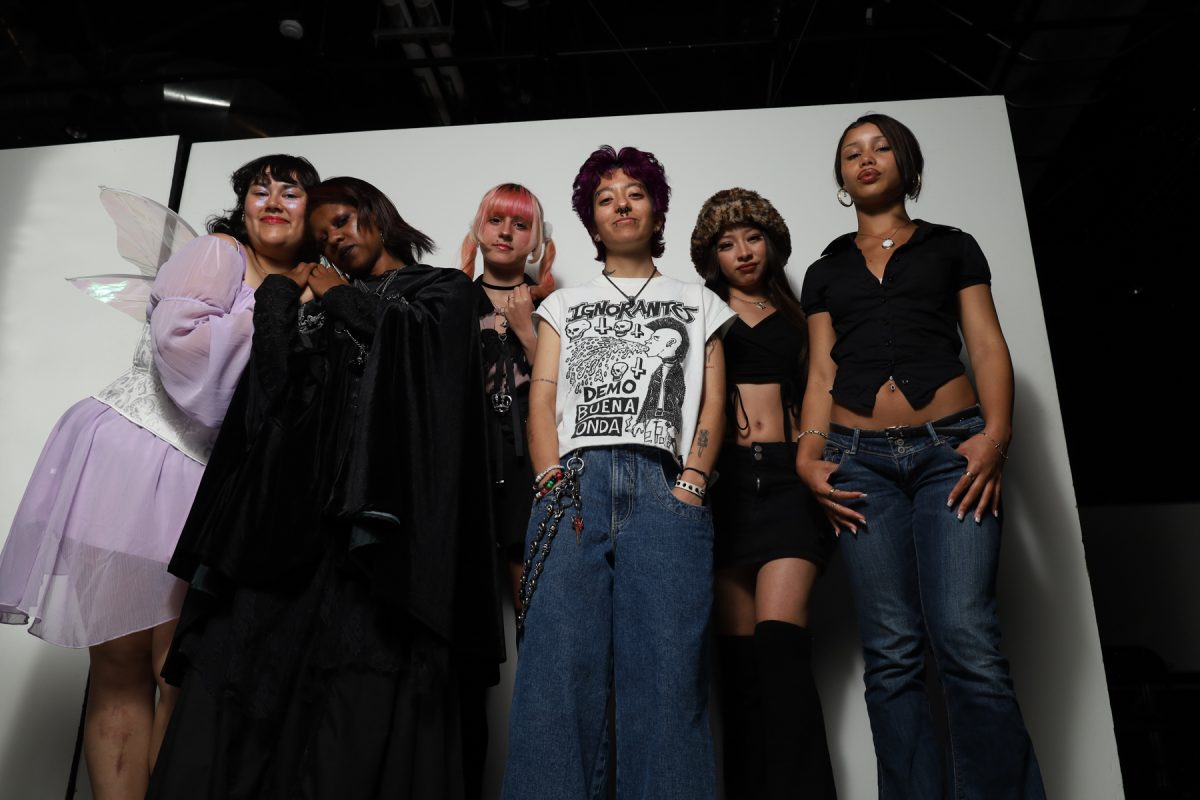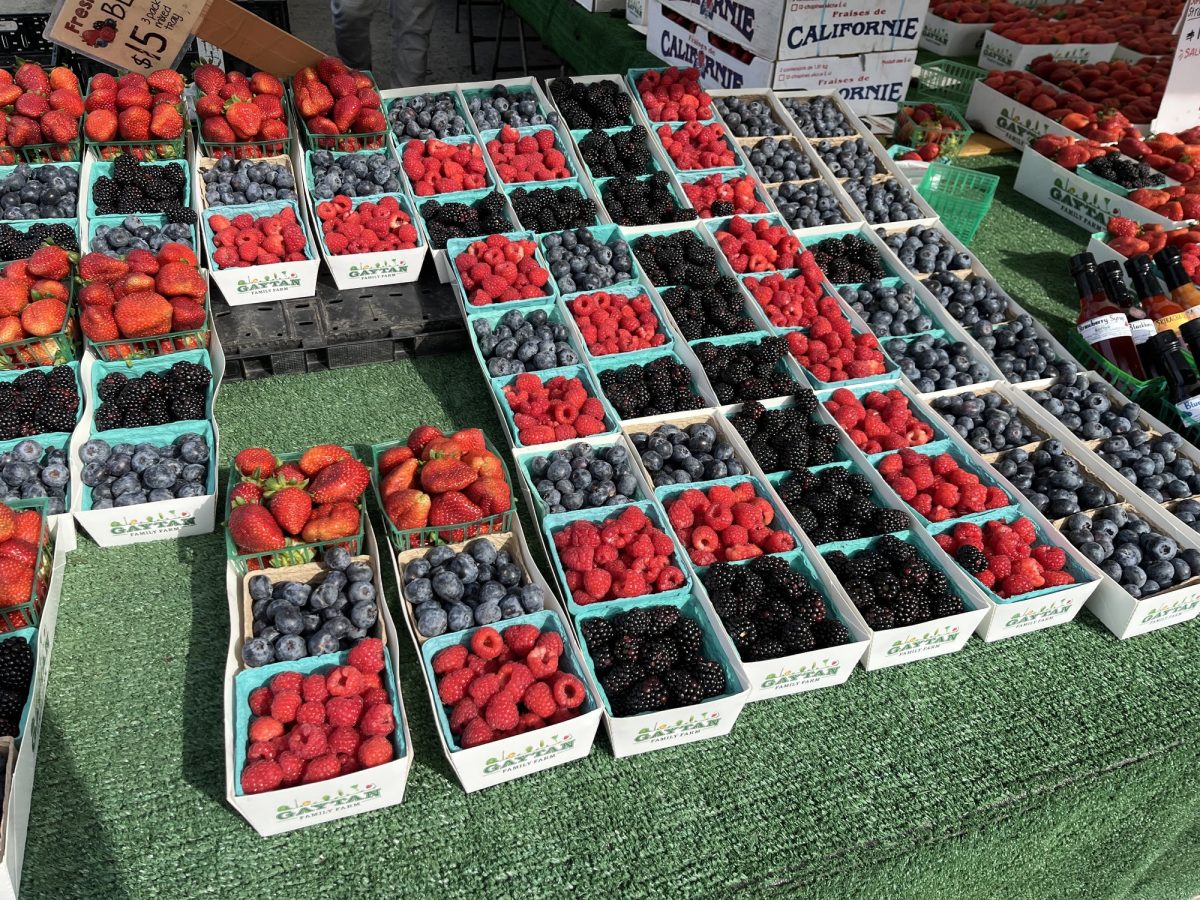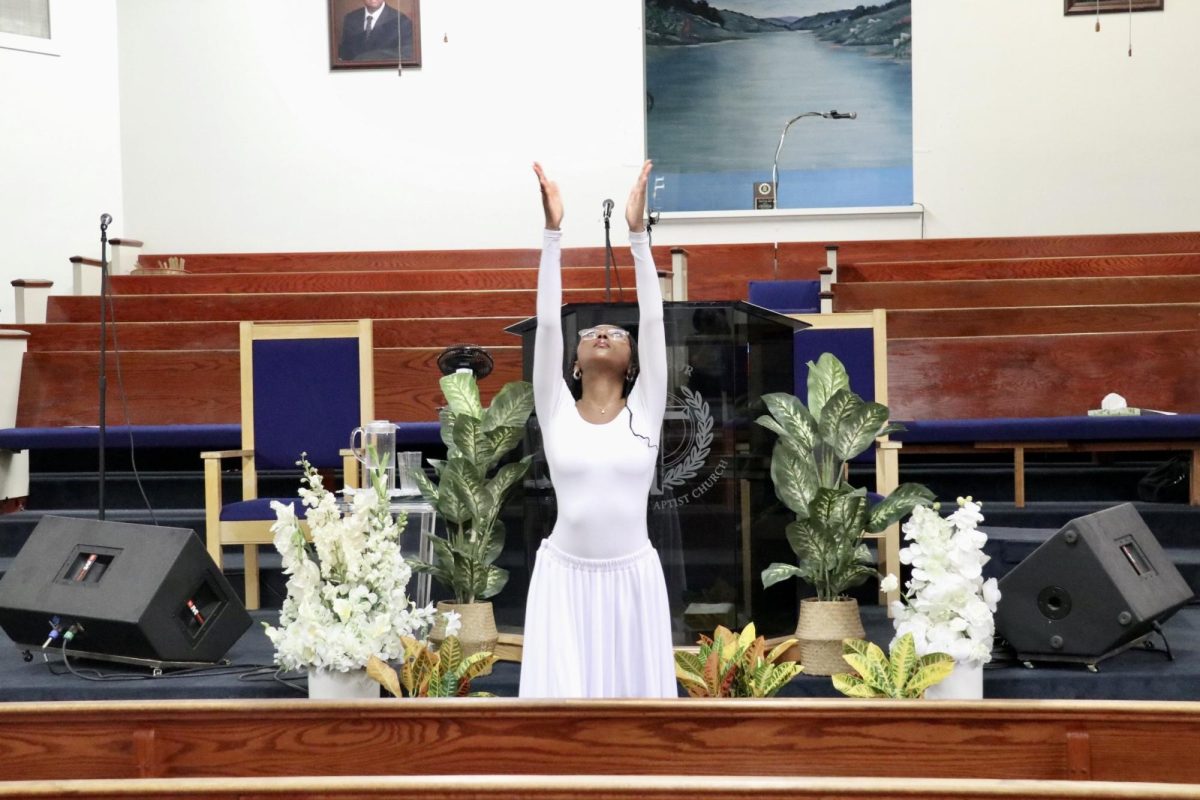Carrie Lockwood was sitting in her kindergarten class when she was a child.
She was cutting a workpiece of paper with scissors.
Her teacher noticed something, knelt beside Lockwood and asked, “Carrie, why can you not cut on the lines?”
She was floored by that question.
“Why do I have to cut on the lines? Why can’t I cut where I want to cut?” Lockwood said to herself.
For Lockwood, that moment is when she knew she had an art mentality.
A rebel artist was born.
Years later, Lockwood, 62, is now an associate at the El Camino College Art Gallery where she helps manage, plan and organize artwork that goes into the 2,000-square-foot gallery for exhibitions.
“Being exposed to all the creativity while being in the gallery learning about different cultures and art practices is phenomenal,” Lockwood said.
Lockwood has been at El Camino for many years as a student and a worker in the Art Department. In between the transition from student to employee, she also worked at the 10,000-square-foot Los Angeles Municipal Art Gallery.
She also has a sales and managerial background from working in retail and real estate where her organizational skills were honed.
When there is an event at the El Camino Art Gallery, you can see her monitoring attendance and making sure the artwork on display is secure.

On other days she creates event promotion flyers, press releases through the El Camino Marketing and Communication division and manages the events calendar and gallery website.
After an exhibition is over, Lockwood helps remove nails on the wall where paintings were hung. She cleans patches and repaints walls.
When patching the walls to repair damages, Lockwood taps a hammer to dent it a bit and then apply spackling paste. Afterward, it is sanded and repainted to look brand new.

For upcoming exhibitions, Lockwood checks her email every day just in case a change is needed with information about an artwork or an artist’s statement.
Lockwood is living the artistic career she always wanted to pursue but at one point was discouraged from doing it since she was told the art field couldn’t help make a living.
The main voice discouraging her from pursuing her passion was from her dad.
Lockwood was born in Texas and moved to Palos Verdes with her family when she was 2 years old.
She graduated from Palos Verdes High School in 1980 and attended Loyola Marymount University for two years.
Lockwood always took art as an elective throughout grade school.
In 1986 she went to the University of Oregon to get her bachelor’s degree in film. She would then move back to Los Angeles to pursue a film career and be on sets.
Her biggest obstacle in college was her father, after he found out she changed her major from business to film.
Afterwards, she went on to work in retail and a real estate company where she used that experience to become an office manager at a mortgage company.
Lockwood’s father owned the family manufacturing company, which made junk mail. Printwork was made along with envelopes and packaging to send out the mail.
She tried to work in the family business for a year and discovered it did not interest her.
“I was miserable,” Lockwood said. “There was no creativity involved in it.”
She spent her time in the office as a customer service representative. The interactions she would get would be visiting with clients to get payments from them or do estimates in quotes for their orders.
“It was not fun, I did the work to make my dad happy, not me,” Lockwood said.
She would just sit in the office, thinking about ways she could make money in the art world.
One day in 2013, while talking with a friend on Facebook, Lockwood learned about El Camino’s art gallery management program.
A few days later she arrived on campus to speak with a counselor, where she was informed about a series of courses that could give her a certificate. A month afterward she was enrolled at El Camino as an art major.
Michael Miller, director of gallery and museum programming, met Lockwood when he was a professor teaching the art gallery management and artist career issues course.
In this class, students learned how to handle and hang artwork in the gallery, fill out loan forms and condition reports and go out into the community to find places to exhibit their artwork.
Lockwood and other students learned these skills as some commercial galleries in San Pedro and Manhattan Beach started inviting the class to do exhibitions inside the Angels Gate Cultural Center and Manhattan Beach Art Center.
Miller said the class would continue until the Great Recession started in 2007, when El Camino ended it due to the costs per student.
After the class ended, students in Miller’s class decided to form a club called Studio to Street, and Lockwood became the club’s first president.
“[Lockwood] was the best president we had in that club, she was very active and really good at organizing all the students to create exhibits,” Miller said.

During the recession, Miller was working at the Los Angeles Municipal Art Gallery as it was laying off or retiring workers.
Due to the amount of layoffs, Miller helped hire Lockwood and other students to work part-time on exhibitions and programs in Hollywood and Barnsdall Art Park.
As a gallery attendant at the Municipal Art Gallery, Lockwood did installations, teardowns and set-ups for exhibitions from 2014 to 2018. Lockwood helped Miller overall with his exhibitions as a studio assistant.
In August 2022, Miller was hired as the El Camino director of gallery and museum programming after the position was created. He needed to hire people to help him work in the old gallery.
The first person he hired was Lockwood.
“I knew she could do all the work,” Miller said.
After a few months of working with Lockwood at the gallery, Miller was told during a meeting with El Camino employees that there was only enough budget for the exhibits, not for all the art programs they wanted to create.
Miller told Lockwood he felt like quitting because they would not have the budget to create engaging programs with students on campus after the pandemic.
Lockwood encouraged Miller to create the programs themselves.
“She knew we could do it, I just needed to hear another person say that,” Miller said.
Other community college art galleries are also impacted by how much budget is given to their department by their respective institutions.
Max Del Bosque, 51, art professor at LA Pierce College, was the director at the LA Pierce Art Gallery from 2009 to 2020.
Del Bosque said to be an art gallery curator at a community college one must have a good understanding of non-profit museum management, people skills, writing and art practice.
“You have to have the ability to sew a silk’s purse out of a sow’s ear, the ability to create something out of very little,” Del Bosque said.
When he was managing the Pierce College Art Gallery, the department would receive anywhere between $0 to $1,000 a year.
Del Bosque said the budgets given to art departments by academic institutions don’t reflect the changing costs of the art world. This affects how college galleries bring in artwork and people to speak at exhibitions.
“The amount of budget given is constantly under threat so [art departments] can’t meet the demands,” Del Bosque said.
Lockwood and Miller developed workshops to demonstrate to El Camino employees the possible impact their programs could have on students.
The gallery was given more funding and Miller was able to hire more workers and create events, including a summer open call where artists in Southern California could bring their art to the gallery and possibly win $500.
“[Lockwood] was really great at helping me develop and create all these type of programs,” Miller said.
Del Bosque said college art galleries play a critical role in the professional development of emerging student and community artists to help create their footing.
“It is important for artists in a community to exchange ideas to help their professional development since they have a freedom to show work in an area not driven by sales,” he said.
Whenever Miller speaks with the El Camino president, vice president or Board of Trustees at a gallery event, he always credits Lockwood and the rest of the workers there.
“Without the entire team we couldn’t do [workshops and events], without the artists we couldn’t do this, it’s all my team that has all these great workshop ideas,” Miller said.
Miller said all of Lockwood’s previous professional work helped her have skills to apply directly to what they are doing in the gallery.

Rod Almazan, El Camino ceramics lab technician, started working at the college in 2017 for both the Ceramics Department and the old Art Gallery in the Art and Behavioral Sciences Building.
At the old Art Gallery, Almazan would install paintings and other artwork while Lockwood was the administrative assistant at the time.
Almazan said Lockwood was very organized by researching and getting artists to display their work in the gallery for exhibits.
“She is really knowledgeable about art, expressing herself through art and knowing what she likes and what would work better [in an art gallery],” Almazan said.
For a year and a half, Lockwood and a small team worked together on preparing exhibits for the Art Gallery. She did promotions, graphic design, technical and legal paperwork for insurance lists and wall labels.
Lockwood enjoyed the time with the small team; it was rewarding since she got to use all the skills she had been trained to use.
“I felt like I had finally arrived, all my experiences in terms of my education and background had finally come to [the Art Gallery] where it was being utilized,” she said.
At the end of every fall semester, Almazan said the workers in the old gallery got together for Christmas parties along with people from other departments to celebrate the work done over the semester.
These annual parties were halted during the COVID-19 pandemic and the transition to the new Art Gallery location in the Arts Complex.
When moving to the new Art Gallery, Miller said a challenge was fitting and organizing everything into a smaller area.
Miller said Lockwood was useful in helping to organize all the gallery materials and moving them to the new gallery.
Once everything was moved into the new gallery, Miller said there wasn’t enough time to create an exhibit and Lockwood was an essential person in developing many workshops and art programs.
“She’s supportive of ideas and I know if I give her an assignment I can count on her to carry it through,” Miller said. “If it had just been me it would have been really tough just doing it alone.”
Lockwood also works as a caregiver for Pirkko De Bar, a former El Camino Art Gallery worker. De Bar had an aneurysm and was in a medical coma for almost a year.
When she came out of the coma, De Bar was in an assisted living facility for a while until she was able to go home. Once back home, De Bar needed help around the house.
Susanna Meiers, former El Camino Art Gallery curator, contacted Lockwood about De Bar’s situation to see if she’d help organize De Bar’s mail. Afterward, Lockwood would also help De Bar do laundry, take out the trash and make doctor’s appointments.
In their time together for four days of the week, they both talk about the gallery. Lockwood brings De Bar art flyers for her to see and talk about the different exhibits and programs.
“She’s always wanting to know what’s going on [at the gallery], what’s the next exhibit and how everyone she knows here is,” Lockwood said.
Some of the challenges Lockwood faces at the gallery are installations, intaking artwork from artists for open-call events, keeping everything organized and figuring out the layout of artwork from a diversity of pieces including ceramics, jewelry, painting and sculptures.
A personal challenge Lockwood has while working at the gallery is a fear of falling from a ladder while using it for installations of artwork or wall repairs.
One time, while walking into a business building in Torrance, Lockwood slipped on a heavily mopped floor, causing her to fall and sprain her arm and leaving her with a new fear of falling.
When using ladders at the gallery, she prefers to use a big step ladder with handles on the side to help her feel secure.
“I don’t like going up just regular ladders because that makes me nervous,” Lockwood said.

When handling and moving artwork around the Art Gallery, Lockwood wears gloves and carefully stacks them on each other, making sure they are faced in a position where they won’t damage one another.
Math is also involved in the artwork installation process at the Art Gallery.
When arranging artwork on the walls inside the gallery, Lockwood said you should have an art piece centered at 58 inches from the ground, which is eye level.
Lockwood also said there’s a lot more math and consideration involved when framing multiple pieces of art around each other.
“It really is a technical skill that has to be taught,” she said.
Lockwood believes having a good idea is the first thing needed when curating an exhibition at an art gallery.
“When you have an idea the pieces fall into place and you keep an eye out for the artists,” she said.
While working at the LA Municipal Art Gallery, Lockwood met many different artists and became familiar with their work, visions and perspectives, which has helped her make connections when creating exhibits.
“It’s really interesting to learn about all these different forms of art other than just painting and drawing,” she said.
Lockwood hopes the El Camino Art Gallery will become an established gallery where people outside of campus visit to see the artwork and elevate the gallery’s reputation.
“It’s more than just a school art gallery, I would like it to have its name out there to the whole community and have people say ‘Yeah you see great exhibits there’,” she said.
Lockwood believes the El Camino Art Gallery is important in getting the students on campus and the community involved in what it offers.
“It’s a beacon of what the imagination can do,” Lockwood said.















